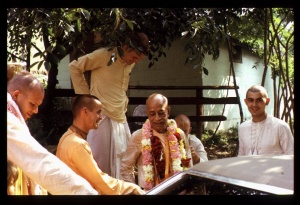CC Madhya 19.169 (1975): Difference between revisions
(Vanibot #0027: CCMirror - Mirror CC's 1996 edition to form a basis for 1975) |
(Vanibot #0020: VersionCompareLinker - added a link to the Version Compare feature) |
||
| Line 2: | Line 2: | ||
<div style="float:left">'''[[Sri Caitanya-caritamrta (1975)|Śrī Caitanya-caritāmṛta (1975)]] - [[CC Madhya (1975)|Madhya-līlā]] - [[CC Madhya 19 (1975)|Chapter 19: Lord Śrī Caitanya Mahāprabhu Instructs Śrīla Rūpa Gosvāmī]]'''</div> | <div style="float:left">'''[[Sri Caitanya-caritamrta (1975)|Śrī Caitanya-caritāmṛta (1975)]] - [[CC Madhya (1975)|Madhya-līlā]] - [[CC Madhya 19 (1975)|Chapter 19: Lord Śrī Caitanya Mahāprabhu Instructs Śrīla Rūpa Gosvāmī]]'''</div> | ||
<div style="float:right">[[File:Go-previous.png|link=CC Madhya 19.168 (1975)|Madhya-līlā 19.168]] '''[[CC Madhya 19.168 (1975)|Madhya-līlā 19.168]] - [[CC Madhya 19.170 (1975)|Madhya-līlā 19.170]]''' [[File:Go-next.png|link=CC Madhya 19.170 (1975)|Madhya-līlā 19.170]]</div> | <div style="float:right">[[File:Go-previous.png|link=CC Madhya 19.168 (1975)|Madhya-līlā 19.168]] '''[[CC Madhya 19.168 (1975)|Madhya-līlā 19.168]] - [[CC Madhya 19.170 (1975)|Madhya-līlā 19.170]]''' [[File:Go-next.png|link=CC Madhya 19.170 (1975)|Madhya-līlā 19.170]]</div> | ||
{{CompareVersions|CC|Madhya 19.169|CC 1975|CC 1996}} | |||
{{RandomImage}} | {{RandomImage}} | ||
==== TEXT 169 ==== | ==== TEXT 169 ==== | ||
<div class="verse"> | <div class="verse"> | ||
:ei | :ei 'śuddha-bhakti'--ihā haite 'premā' haya | ||
:pañcarātre, bhāgavate ei lakṣaṇa kaya | :pañcarātre, bhāgavate ei lakṣaṇa kaya | ||
</div> | </div> | ||
| Line 18: | Line 17: | ||
<div class="synonyms"> | <div class="synonyms"> | ||
ei—this; śuddha-bhakti—pure devotional service; ihā haite—from which; premā—unalloyed love of Kṛṣṇa; haya—there is; pañcarātre—in the Vedic | ei—this; śuddha-bhakti—pure devotional service; ihā haite—from which; premā—unalloyed love of Kṛṣṇa; haya—there is; pañcarātre—in the Vedic literature known as the Pañcarātras; bhāgavate—also in Śrīmad-Bhāgavatam; ei—these; lakṣaṇa—symptoms; kaya—are described. | ||
</div> | </div> | ||
| Line 25: | Line 24: | ||
<div class="translation"> | <div class="translation"> | ||
"These activities are called śuddha-bhakti, pure devotional service. If one renders such pure devotional service, he develops his original love for Kṛṣṇa in due course of time. In Vedic literatures like the Pañcarātras and Śrīmad-Bhāgavatam, these symptoms are described. | |||
</div> | </div> | ||
| Line 32: | Line 31: | ||
<div class="purport"> | <div class="purport"> | ||
One has to develop his devotional service under the directions of a pure devotee, the spiritual master, and in accordance with the Vedic directions given in the Pañcarātra and | One has to develop his devotional service under the directions of a pure devotee, the spiritual master, and in accordance with the Vedic directions given in the Pañcarātra and Bhāgavatam systems. The Pañcarātra system includes methods of temple worship, and the Bhāgavatam system includes the spreading of Kṛṣṇa conscious philosophy through the recitation of Śrīmad-Bhāgavatam and the discussion of philosophy with people who are interested. Through discussion, one can create an interest and understanding of the Pañcarātra and Bhāgavatam systems. | ||
</div> | </div> | ||
Latest revision as of 11:49, 27 January 2020

A.C. Bhaktivedanta Swami Prabhupada
TEXT 169
- ei 'śuddha-bhakti'--ihā haite 'premā' haya
- pañcarātre, bhāgavate ei lakṣaṇa kaya
SYNONYMS
ei—this; śuddha-bhakti—pure devotional service; ihā haite—from which; premā—unalloyed love of Kṛṣṇa; haya—there is; pañcarātre—in the Vedic literature known as the Pañcarātras; bhāgavate—also in Śrīmad-Bhāgavatam; ei—these; lakṣaṇa—symptoms; kaya—are described.
TRANSLATION
"These activities are called śuddha-bhakti, pure devotional service. If one renders such pure devotional service, he develops his original love for Kṛṣṇa in due course of time. In Vedic literatures like the Pañcarātras and Śrīmad-Bhāgavatam, these symptoms are described.
PURPORT
One has to develop his devotional service under the directions of a pure devotee, the spiritual master, and in accordance with the Vedic directions given in the Pañcarātra and Bhāgavatam systems. The Pañcarātra system includes methods of temple worship, and the Bhāgavatam system includes the spreading of Kṛṣṇa conscious philosophy through the recitation of Śrīmad-Bhāgavatam and the discussion of philosophy with people who are interested. Through discussion, one can create an interest and understanding of the Pañcarātra and Bhāgavatam systems.